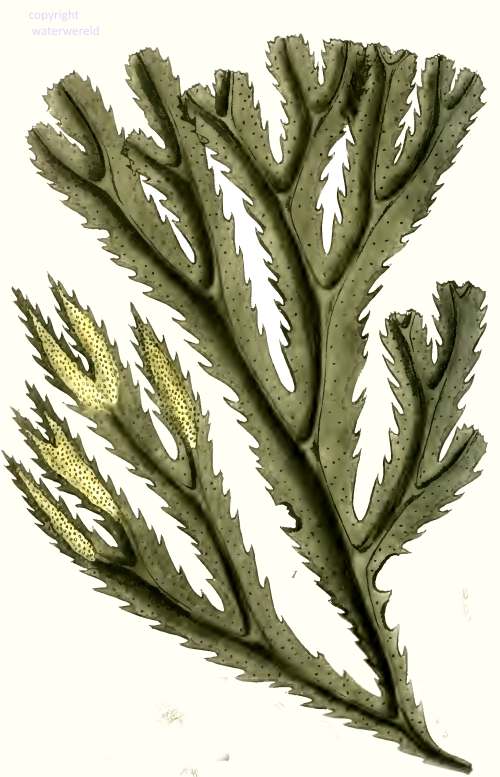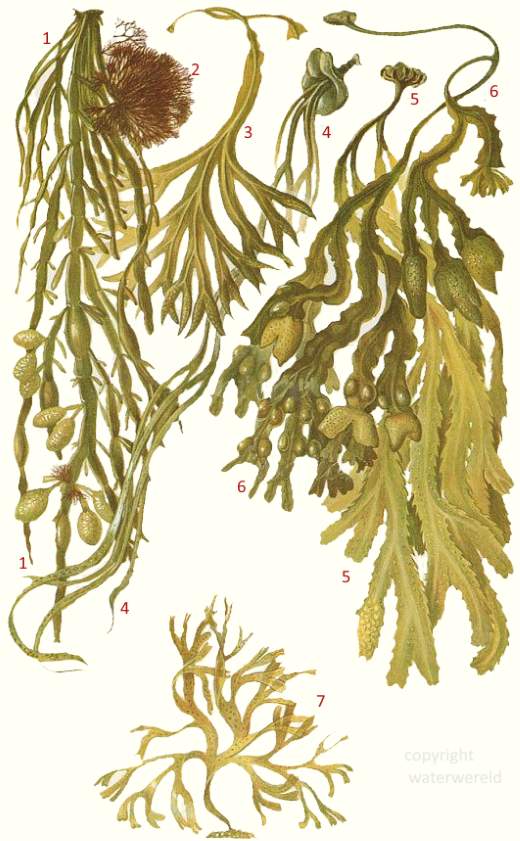toothed wrack or serrated wrack
The serrated wrack, often called 'toothed' or 'saw', is a very common wrack on rocky shores. It can be found on all the northern shores from the Atlantic ocean on both the European and North American coasts. It grows just above the low water mark and is often covered by other seaweed. This wrack has no airbladders. The blades are a meter long and have serrated edges and a clearly visable mid-rib.
toothed wrack uses
Fucus serratus is harvested by hand at low tide. It is mainly used as a fertilizer and as a food. In Ireland and France it is used for the production of seaweed extracts for cosmetics, and for seaweed baths.

Toothed wrack or fucus serratus, the frond surface of Fucus serratus has numerous pin-pricks with clusters of tiny white hairs or tufts. The conceptacles can be found under these small tufts on the blades.
Bladderwrack and toothed wrack
Both bladderwrack and toothed wrack can be found on the same rocks near the sea. They both can be found between rocky parts of the lower shore, exposed or immersed in rock pools, and on all but the most exposed shores. But Bladderwrack is always on top and there is sharp demarcation between the seaweeds (this is called stratification).
look alikes
Fucus vesiculosus has paired vesicles and does not have a saw-toothed edge. Fucus spiralis has inflated terminal receptacles and the blades formed in a spiral.

Seaweeds of the North sea.
1 Ascophyllum nodosum
2 Polysymphonia lanosa
3 horned wrack or fucus ceranoides
4 Bladder wrack or fucus vesiculosus
5 toothed wrack or serrated wrack or fucus serratus
6 Sea Spaghetti or Himanthalia elongata
7 forkweed or Dictyota dichotona
).

Seaweeds from the Northsea from P. Kuckuck.
1 Bladder Wrack or Fucus vesiculosus
2 Toothed Wrack or Serrated Wrack or Fucus serratus
3 Norwegian Kelp, Knotted Kelp, Knotted Wrack or Egg Wrack or Ascophyllum nodosum
4 Thongweed, Sea Thong or Sea Spaghetti or Himanthalia ellongata
5 Sea Oak or Halidrys siliquosa
6 forkweed or Dictyota dichotoma
P. Kuckuck
Dr Paul Kuckuck is the writer of the book "Der Strandwanderer".
The first edition started in 1905, the last one in 1977.On this website you can find these illustrations :
barnacles
the sea slater
starfish
light-bulb tunicate
Whelks, limpets and periwinkles
Sponges and sea anemones
Cockles
sea beech
Oarweed
teredo worm or shipworm
hydrozoids
sea-lettuce or ulva